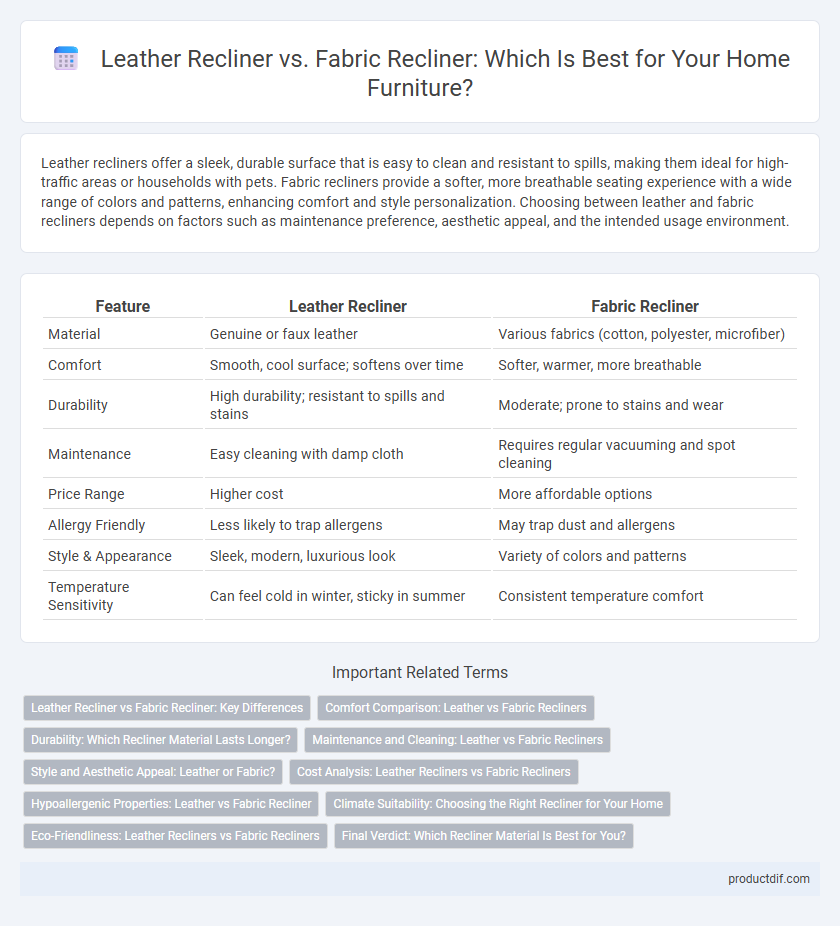Leather recliners offer a sleek, durable surface that is easy to clean and resistant to spills, making them ideal for high-traffic areas or households with pets. Fabric recliners provide a softer, more breathable seating experience with a wide range of colors and patterns, enhancing comfort and style personalization. Choosing between leather and fabric recliners depends on factors such as maintenance preference, aesthetic appeal, and the intended usage environment.
Table of Comparison
| Feature | Leather Recliner | Fabric Recliner |
|---|---|---|
| Material | Genuine or faux leather | Various fabrics (cotton, polyester, microfiber) |
| Comfort | Smooth, cool surface; softens over time | Softer, warmer, more breathable |
| Durability | High durability; resistant to spills and stains | Moderate; prone to stains and wear |
| Maintenance | Easy cleaning with damp cloth | Requires regular vacuuming and spot cleaning |
| Price Range | Higher cost | More affordable options |
| Allergy Friendly | Less likely to trap allergens | May trap dust and allergens |
| Style & Appearance | Sleek, modern, luxurious look | Variety of colors and patterns |
| Temperature Sensitivity | Can feel cold in winter, sticky in summer | Consistent temperature comfort |
Leather Recliner vs Fabric Recliner: Key Differences
Leather recliners offer superior durability and easy maintenance compared to fabric recliners, making them ideal for high-traffic areas and families with pets. Fabric recliners provide greater variety in textures and patterns, offering enhanced comfort and warmth but require more frequent cleaning and are prone to staining. Choosing between leather and fabric recliners depends on factors such as lifestyle, budget, and desired aesthetic, with leather emphasizing sleek elegance and fabric prioritizing cozy ambiance.
Comfort Comparison: Leather vs Fabric Recliners
Leather recliners offer a smooth, cool surface that adapts to body temperature, providing firm support and easy maintenance, making them ideal for those seeking durability and a sleek appearance. Fabric recliners deliver a softer, warmer feel with breathable materials that enhance coziness and prevent heat buildup, perfect for extended lounging and comfort. Both options vary in comfort preferences, with leather excelling in elegance and longevity, while fabric prioritizes warmth and plush cushioning.
Durability: Which Recliner Material Lasts Longer?
Leather recliners typically offer superior durability due to their resistance to wear, stains, and tearing, making them ideal for high-traffic areas and long-term use. Fabric recliners, while often more breathable and versatile in design, tend to show signs of wear and fading faster, especially if exposed to sunlight or frequent use. Choosing full-grain leather enhances longevity significantly compared to synthetic fabrics, which may degrade more quickly under regular stress.
Maintenance and Cleaning: Leather vs Fabric Recliners
Leather recliners require regular wiping with a damp cloth and occasional application of leather conditioner to prevent cracking and maintain suppleness, making them resistant to stains and easier to clean. Fabric recliners need frequent vacuuming and spot cleaning with upholstery cleaners to remove dust and spills, but they may absorb odors and stains more easily than leather. Proper maintenance for leather involves conditioning every 6-12 months, while fabric often demands more routine and intensive cleaning to preserve appearance and durability.
Style and Aesthetic Appeal: Leather or Fabric?
Leather recliners offer a sleek, polished look that complements modern and sophisticated interiors, providing a timeless aesthetic that ages well with natural patina. Fabric recliners come in a wide variety of textures, patterns, and colors, allowing for greater customization and a cozy, inviting atmosphere suitable for traditional or casual decors. Choosing between leather and fabric ultimately depends on the desired style impact and the existing design elements of the living space.
Cost Analysis: Leather Recliners vs Fabric Recliners
Leather recliners typically cost between $800 and $2,500 due to premium materials and durability, while fabric recliners range from $300 to $1,200, offering more budget-friendly options. Maintenance expenses for leather include specialized cleaning products and conditioning treatments, increasing long-term costs compared to fabric, which often requires simpler, less expensive care such as vacuuming and spot cleaning. However, leather recliners generally retain resale value better than fabric, making them a more cost-effective investment over time despite the higher initial price.
Hypoallergenic Properties: Leather vs Fabric Recliner
Leather recliners offer superior hypoallergenic properties due to their non-porous surface, which resists dust mites, pet dander, and allergens more effectively than fabric upholstery. Fabric recliners tend to trap allergens within their fibers, requiring more frequent cleaning to maintain a hypoallergenic environment. Opting for leather recliners benefits individuals with allergy sensitivities by promoting cleaner air quality and reducing allergen buildup.
Climate Suitability: Choosing the Right Recliner for Your Home
Leather recliners excel in warm climates due to their durability and ease of cleaning, while fabric recliners provide better breathability and comfort in cooler environments. When selecting a recliner, consider humidity levels and temperature fluctuations to ensure the material aligns with your home's climate. Opt for leather in hotter regions to resist moisture and spills, and choose fabric recliners in colder areas for softer, cozier seating.
Eco-Friendliness: Leather Recliners vs Fabric Recliners
Leather recliners often have a higher environmental impact due to the intensive resources and chemicals used in tanning leather, while many fabric recliners utilize sustainable materials such as organic cotton, linen, or recycled fibers. Fabric recliners typically offer better biodegradability and lower carbon footprints, especially when produced with eco-friendly dyes and manufacturing processes. Choosing furniture with certifications like GREENGUARD or OEKO-TEX ensures reduced emissions and toxins, supporting healthier indoor environments and eco-conscious living.
Final Verdict: Which Recliner Material Is Best for You?
Leather recliners offer durability, easy maintenance, and a sleek appearance, making them ideal for high-traffic areas or homes with pets and children. Fabric recliners provide superior comfort, breathability, and a wider range of colors and patterns, better suited for cozy, casual settings. Choosing between leather and fabric recliners depends on your lifestyle, budget, and aesthetic preferences to ensure long-term satisfaction.
Leather recliner vs Fabric recliner Infographic

 productdif.com
productdif.com